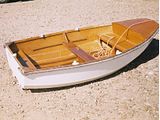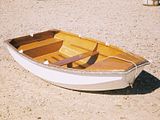I am getting down to using my newly serviced Seagull, and have several observations. I don't know whether these are well known, or I am doing something wrong:
1) There is nothing to brace the motor against while starting, other than rather precariously holding the petrol tank while trying to avoid having my wrist sliced by the cord winder.
I have tried fitting a bar of metal across the front two casing bolts (longer bolts used) so that it projects across the top of the tiller. This limits the upward swing of the tiller, and means it can be used to steady the motor and resist the pull of the cord. It is now possible to sit further away from the engine, brace one foot on the transom, and avoid the problem of submerging the exhaust outlet too deep while sitting right in the stern.
It seems such an obvious improvement.
2) The instructions on the petrol tank stress always start with FULL throttle.
I find this to be the surest way of making it impossible to start. My new method is full choke, ONE pull at full throttle, then it starts on the second pull at half-throttle.
3) Petrol leaking out when tilting. Tilting the engine and hooking it down causes it to flop over one way or the other. Presumably the vent hole in the float chamber should then be on top. But the major source of leak is from around the tickler pin. Is that supposed to have some kind of seal, or is it normal to tip a chamber full of petrol into the bottom of the boat?
Steadying motor while starting
Moderators: John@sos, charlesp, Charles uk, RickUK, Petergalileo
-
Clifford Pope
- Posts: 39
- Joined: Sun Nov 05, 2006 1:37 pm
- Location: West Wales
1. I have a couple of Seagulls which i have been using for around 30 years. I always steady them with a hand on the fuel tank when starting them. I have, in all that time, not sliced my wrist!
2. I find my engines will start at half throttle or a little less. (and full choke)
3. There is no seal on the tickler (Villiers carb). Petrol does just pour out when the engine is tilted but this can be minimised by shutting off the fuel and allowing the engine to burn off as much of the fuel in the carb as possible. After a while one learns to judge how far it will travel before it stops.
2. I find my engines will start at half throttle or a little less. (and full choke)
3. There is no seal on the tickler (Villiers carb). Petrol does just pour out when the engine is tilted but this can be minimised by shutting off the fuel and allowing the engine to burn off as much of the fuel in the carb as possible. After a while one learns to judge how far it will travel before it stops.
-
Clifford Pope
- Posts: 39
- Joined: Sun Nov 05, 2006 1:37 pm
- Location: West Wales
I can see how that would work if the engine is mounted low down, and you can bend over it from above. But sitting on a thwart in a small dinghy puts the flywheel at about chest height, so it is very difficult to brace the engine without risk of touching the flywheel. The boat isn't really stable enough to stand up in.
-
Clifford Pope
- Posts: 39
- Joined: Sun Nov 05, 2006 1:37 pm
- Location: West Wales
In just re-read that bit "brace one foot on the transom" why?It is now possible to sit further away from the engine, brace one foot on the transom, and avoid the problem of submerging the exhaust outlet too deep while sitting right in the stern
In the little dinghy pictured, (it's a tad less than 8ft long) I kneel, place my left hand on the tank and yank the string with my right hand.
I really don't see the problem.
Submerging the exhaust outlet does not seem to be a problem either.
My main concern is immersing the transom. That tends to be a problem when tied up along side the boat when its a bit choppy and is a nuisance because then the dinghy fills with water.

